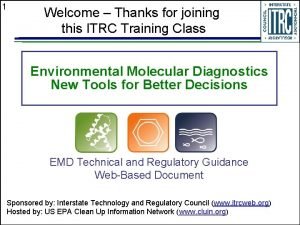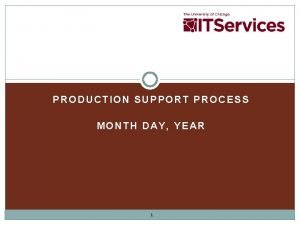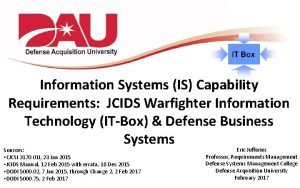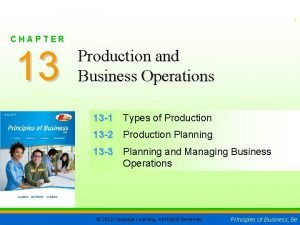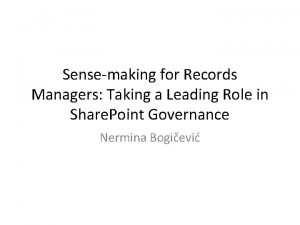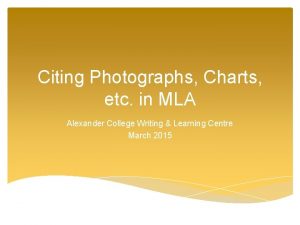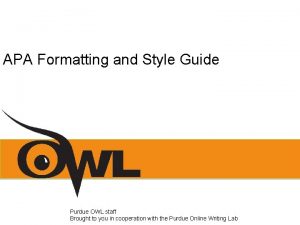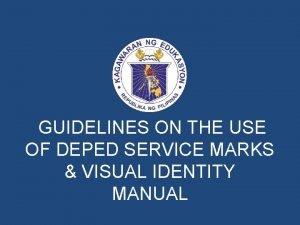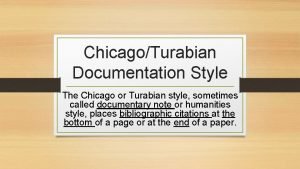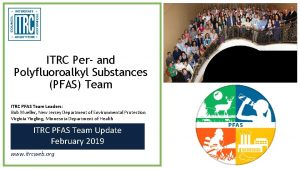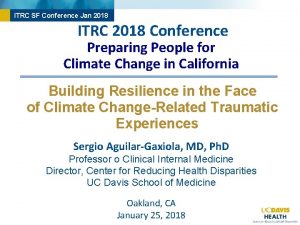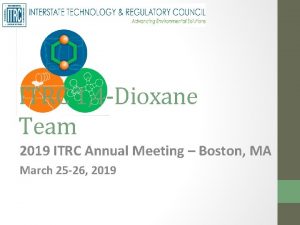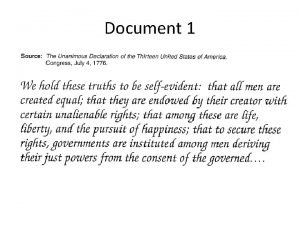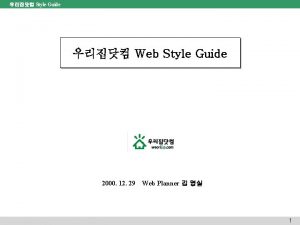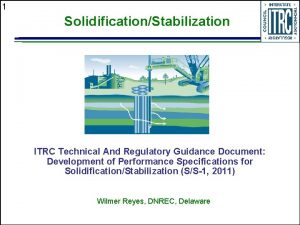ITRC Document Style and Production Guide ITRC Style












- Slides: 12

ITRC Document Style and Production Guide

ITRC Style is Based on: • Chicago Manual of Style (CMS), 16 th ed. , for general guidance on grammar, style, and format • Merriam-Webster’s Collegiate Dictionary (Webster’s), 11 th ed. , for word usage and hyphenation guidance • Scientific Style and Format: The CSE Manual for Authors, Editors, and Publishers, 8 th ed. for technical style issues not addressed in CMS • Mc. Graw-Hill Dictionary of Scientific and Technical Terms, for technical terms not provided in Webster’s • Federal Plain Language Guidelines, for guidelines to help authors simplify technical material for ITRC audience

Artwork • Can use original figures/graphics or copyrighted figures/graphics • Original graphics can be created by the team and finalized by ITRC graphic artist • Figures/graphics from copyrighted materials may be used WITH PERMISSION FROM THE ONE WHO HOLDS COPYRIGHT • Each figure/graphic needs a copyright approval form

Writing • Use ITRC styles in the ITRC Word template • Styles are loaded into the template • Correct fonts • Correct title format • Correct format for table and figure titles • Don’t add styles – let me know if you need a style! • Use clear, concise language • Active voice • “You. . . “

Tables • Introduce tables in the text paragraph immediately preceding the table. • Tables should be sized to fit within 1 -inch margins on 8. 5 x 11 pages. • The first left-hand column should use title case (This is Title Case). Otherwise, sentence case should be used for the table text unless caps are otherwise warranted. • Abbreviations should be spelled out in the table’s footnotes. • Table titles should be succinct, in noun form, and describe the data but not interpret the data. Only the first word of the table title is capitalized and no period is needed at the end of the title. • Tables cannot be inserted as images or graphic files from a source file. • To insert a new table, use the Insert tab and “Table”.

Lists • Introduce vertical lists with a complete sentence followed by a colon. • Use bulleted lists unless the context dictates numerical ranking due to chronology, sequence, or importance. • Make list items grammatically parallel – all items should use similar parts of speech, phrases, or complete sentences. • When bulleted list items are not complete sentences, do not capitalize, do not end with punctuation, and do not use “and” before the next-to-last list item. • When bulleted list items are complete sentences, capitalize the first word and use appropriate end punctuation. • Single space the entire list. • Use sub-bullets sparingly

Hyperlinks • Link to other parts of the document • Section headers • Bookmarks within the document • Link to outside documents • In general, links within the document open in the same window, links to outside documents open in a new window

Other stuff • Read More • Text is hidden unless reader clicks on “Read More” • In document, mark hidden text in green • read more start here • read more stop • Acronyms • Define at first use • Use acronym (vs entire string of words) if it is used more than 5 times in the document

Figures • Introduce figures in a text paragraph and place them immediately after the text reference. • Do not put figures in text boxes - Text box placement is lost in the file import process. • Any text within a figure should be in sentence case. • Include the figure caption and source (if ITRC did not generate the figure) on text lines beneath the figure. Select the "Figure Caption" and "Figure Source" styles for each line. • Figures can be embedded in the draft Word file – but include the original files (at appropriate resolution and editable if possible) for any graphics used.

References • Authors must provide full bibliographic information for any references cited! • Use author-date system for citations in the text. • List up to three authors • For four authors or more, use et al. • Put the full reference in the reference section. • Publications which provide additional information, but are not cited can be listed as “Additional Resources” in an appendix.

References • Provide Digital Object Identifier for all citations, if available. • Journal article: Aitken, C. M. , D. M. Jones, and S. R. Larter. 2004. “Anaerobic hydrocarbon biodegradation in deep surface oil reservoirs. ” Nature 431: 291 -4. http: //www. nature. com/articles/nature 02922 • Chapter in a book: Diamond, S. A. 2003. “Photoactivated toxicity in aquatic environments, ” pp. 177 -85 in UV Effects in Aquatic Organisms and Ecosystems, E. W. Helbling and H. Zagarese, eds. John Wiley & Sons, Inc. https: //books. google. com/books? hl=en& lr=& id=45 pupa. Ul_j. UC& oi=fnd&am p; pg=PA 219& dq=Photoactivated+toxicity+in+aquatic+environments. +& ots=b. ORi i. Bw. WDl& sig=gds. IP_Df. Ktt. Uo. TZUt 2 yd. RO 3 m. FU#v=onepage& q& f=false • Book: Altgelt, K. H. , and M. M. Boduszynski. 1994. Composition and Analysis of Heavy Petroleum Fractions. New York: M. Dekker. http: //www. worldcat. org/title/composition-and-analysisof- heavy-petroleumfractions/oclc/29024018 • Report: ANZECC. (Australian and New Zealand Environment and Conservation Council). 2008. Australian and New Zealand Guidelines for Fresh and Marine Water Quality: Volume 2— Aquatic ecosystems—rationale and background information. October 2008. http: //www. agriculture. gov. au/Site. Collection. Documents/water/nwqmsguidelines-4 -vol 2. pdf • In conference proceedings: Hokstad, J. N. , L. G. Faksness, P. S. Daling, and M. Buffagni. 2000. Chemical and Toxicological Characterization of Water-Accommodated Fractions Relevant for Oil Spill Situations. SPE International Conference on Health, Safety and Environment in Oil and Gas Exploration and Production, 26 -28 June, Stavanger, Norway. http: //dx. doi. org/10. 2118/61468 -MS

Requirements for a Complete Draft Document ü The document (including appendices) is no more than 300 pages (excluding all cover materials and references). ü The document uses the ITRC document template. ü The narrative style is written in plain language, making the document more accessible to all readers. ü All external and internal hyperlinks are provided in-text and are functional. ü Tables are formatted as tables within the document (not images), and use the correct title format. ü The glossary and acronym terms are defined. ü All graphics are properly cited and captioned, and have a corresponding Graphics Copyright Approval Form. ü All graphics are available in the Word document and are clear, readable, and contain enough contrast. ü The PA uses End. Note for reference management. �All references are complete (noted in-text and sourced). ü Team members have collectively reviewed the complete draft (not only their own sections). ü Web features that are not part of the Word document are complete (Home Page, Navigating this Website/About this Website, Navigation Menu, and Footer)
 Production process flow chart
Production process flow chart Itrc training
Itrc training Document.write(document.cookie)
Document.write(document.cookie) Document production software
Document production software Production support process
Production support process Jcids icd
Jcids icd Chapter 13 study guide production and business operations
Chapter 13 study guide production and business operations Iron mountain european document retention guide 2019
Iron mountain european document retention guide 2019 What is block letter style with open punctuation
What is block letter style with open punctuation Alexander college mla style guide
Alexander college mla style guide Purdue apa
Purdue apa Deped 31 s 2019
Deped 31 s 2019 Menlo school library chicago style guide
Menlo school library chicago style guide

